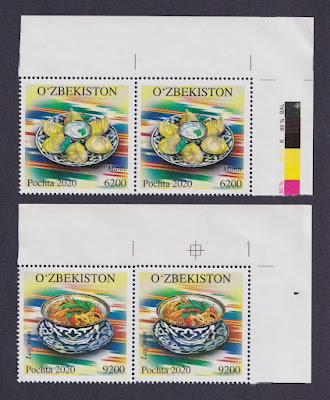Technical Details:Issue Date:22 April 2025
Process: Offset
Size:Stamp: 57,6 X 40,9 mm, Minisheet: 150,6 x 86,4 mm
Values: €4.60
About Gastronomy - Spain in 19 Dishes - Aragon, Pollo al Chilindrón
Correos continues its gastronomic journey through Spain with its series Gastronomy Spain in 19 Dishes. This April, the chosen autonomous community is Aragon, and the dish: chicken al chilindrón.
Chilindrón is a stew, or sauce for others, that encapsulates many of the virtues of the cuisine of the Ebro Valley, including La Rioja, Navarra, and Aragon. It's a dish that never travels. Few chilindrones exist beyond its native region. It captures the essence of traditional Aragonese cuisine. Cuisine from the garden and the farmyard. Simple and austere. Simple recipes that require a good hand, calm, and quality products.
For the Aragonese, chilindrón is a stew based on humble ingredients from the garden, such as peppers, tomatoes, and onions, with garlic and ham if desired, which are combined in the casserole with farmyard products: mainly chicken, but also lamb, rabbit, or even pigeon. The meat may vary, but the procedure is always the same. Delving into the origins of the dish requires going back centuries, but not many. Chilindrón stew is a relatively new dish. It could only have existed after the discovery of America, as both peppers and tomatoes arrived in Spain from there. There are no pre-Columbian antecedents of our recipe. Peppers were incorporated into Spanish, and therefore European, cuisine around 450 years ago, and tomatoes around 300 years ago.
The essence of Aragonese chilindrón is its inextricable marriage with chicken, the chicken of yesteryear, aged for several months, with a dense flavor, firm bones, savory meat, and a gelatinous sauce that sticks to your snout. Of course, always with good, crusty bread to dip and a glass of good red wine to accompany it, the kind you drink for pleasure, not because you're thirsty.
It's true that the preparation spread to other regions of the Ebro Valley, but it was in Huesca where the recipe took root during the second half of the 19th century. In Huesca, it's traditional for it to be part of the menu in homes and restaurants on the capital's most important day, August 10th, the feast of San Lorenzo, the city's patron saint and the center of the Laurentian festivities.
As with everything, it must have a certain mystery, otherwise excitement would be lacking, so the word chilindrón has several meanings. For some, including the Royal Academy of the Spanish Language, in addition to being a stew, it refers to an ancient card game called chilindrón, which refers to the combination of the jack, the knight, and the king. For others, including Darío Vidal Llisterri, chilindrón is a method, a way of cooking, and its name comes from the fact that it is cooked using chilindrón peppers grown in Calamocha. Its origin most likely lies in the word "chili," a pepper, one of its basic ingredients. The greatest charm of the word—chilindrón—perhaps lies in not knowing where it comes from, where it goes, or what secret it hides beneath its various masks.
CHICKEN AL CHILINDRÓN RECIPE
Ingredients:
• One 4 kg free-range chicken
• Onion
• Red peppers
• Tomatoes
• 1 head of garlic
• Teruel DOP ham
• White wine
• EVOO
• Salt
• Pepper
Preparation:
• In a clay pot, pour the oil and a head of garlic and cook over low heat. Chop the chicken. Remove the garlic head when it's browned and add the chicken, brown it, and set aside.
• Add the grated onion and cover to cook. When it's soft, add the ham, cut into small, thin slices.
• Roast the peppers over low heat and rest them in a plastic bag for 30 minutes. Rinse with cold water, peel, deseed, and remove the seeds. Cut into squares and add. Stir with a wooden spoon.
• Blanch the tomatoes for one minute, peel, deseed, chop, and add. When the tomato sauce is tender, add the chicken and cook until the bones and meat are tender.
• Add a small glass of white wine at the last minute and bring to a boil.
• Cut long strips of red pepper and place them on top of the stew.
Recipe by Carmelo Bosque Allúe (Lillas Pastia restaurant in Huesca) included in the "Golden Book of Aragonese Cuisine" by academics Cristina Arguilé Martínez, Juan Barbacil Pérez, and Miguel Angel Vicente Val, along with Cristina Martínez Lalana.
































